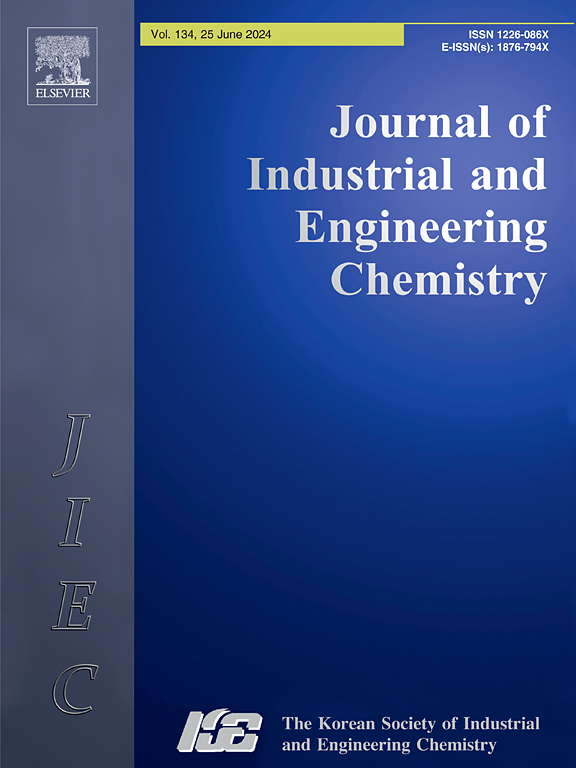Initial exploration of solution-processed ultrapure blue organic light emitting diodes utilizing phosphorescent Pt complex and MR-TADF emitters
IF 5.9
3区 工程技术
Q1 CHEMISTRY, MULTIDISCIPLINARY
Journal of Industrial and Engineering Chemistry
Pub Date : 2025-01-25
DOI:10.1016/j.jiec.2024.07.012
引用次数: 0
Abstract
To achieve very high efficiency in solution-processed organic light emitting diodes (OLEDs), one promising and trailblazing approach is the utilization of the phosphor sensitized fluorescence (PSF) mechanism. In our study, we successfully apply this mechanism to fabricate highly efficient blue solution-processed device by introducing novel structured platinum (Pt) complex as a phosphorescent sensitizer. The significant spectral overlap between the sensitizer and final dopant (JF), with a JF value of 14.83 × 1014 nm4 M−1 cm−1, enables high rates of energy transfer and results in a moderately high external quantum efficiency, with the device displaying (0.12, 0.12) color coordinates while achieving a notable 9.68 % external quantum efficiency. The system is particularly promising for designing OLEDs with sub-microsecond radiation decay times. Additionally, the PSF emitter exhibits ultrapure blue emission, with a narrow full-width half maximum of 16 nm from photoluminescence and 18 nm from electroluminescence. Moreover, the radial distributions of EML molecules at different annealing temperatures were investigated, showing the absence of molecular aggregation, ensuring a smooth surface for the solution device. These findings highlight the promising potential of employing the PSF mechanism along with a stable interfacial layer to achieve remarkable performance in solution-processed OLED devices.

利用磷光铂络合物和 MR-TADF 发射器的溶液处理超纯蓝色有机发光二极管初探
为了在溶液处理有机发光二极管(oled)中实现非常高的效率,利用荧光粉敏化荧光(PSF)机制是一种有前途和开创性的方法。在我们的研究中,我们通过引入新型结构铂(Pt)配合物作为磷光敏化剂,成功地将这一机制应用于制造高效的蓝色溶液处理装置。敏化剂和最终掺杂剂(JF)之间显著的光谱重叠,JF值为14.83 × 1014 nm M−1 cm−1,实现了高的能量转移率,并获得了中等高的外部量子效率,器件显示(0.12,0.12)色坐标,同时实现了显着的9.68%的外部量子效率。该系统在设计亚微秒辐射衰减时间的oled方面特别有前景。此外,PSF发射体表现出超纯蓝色发射,光致发光和电致发光的全宽半最大值分别为16 nm和18 nm。此外,研究了EML分子在不同退火温度下的径向分布,表明没有分子聚集,确保了溶液装置的表面光滑。这些发现强调了利用PSF机制和稳定的界面层在溶液处理OLED器件中实现卓越性能的巨大潜力。
本文章由计算机程序翻译,如有差异,请以英文原文为准。
求助全文
约1分钟内获得全文
求助全文
来源期刊
CiteScore
10.40
自引率
6.60%
发文量
639
审稿时长
29 days
期刊介绍:
Journal of Industrial and Engineering Chemistry is published monthly in English by the Korean Society of Industrial and Engineering Chemistry. JIEC brings together multidisciplinary interests in one journal and is to disseminate information on all aspects of research and development in industrial and engineering chemistry. Contributions in the form of research articles, short communications, notes and reviews are considered for publication. The editors welcome original contributions that have not been and are not to be published elsewhere. Instruction to authors and a manuscript submissions form are printed at the end of each issue. Bulk reprints of individual articles can be ordered. This publication is partially supported by Korea Research Foundation and the Korean Federation of Science and Technology Societies.

 求助内容:
求助内容: 应助结果提醒方式:
应助结果提醒方式:


